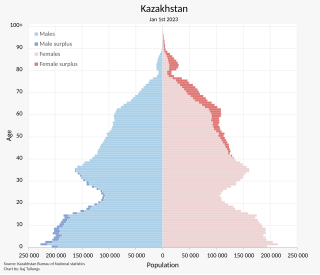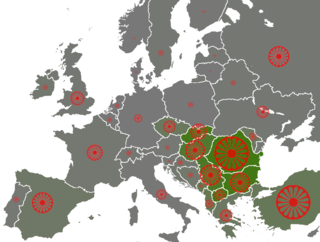
Demographic features of the population of Hong Kong include population density, ethnicity, education level, the health of the populace, religious affiliations, and other aspects.

The demographics of Kazakhstan enumerate the demographic features of the population of Kazakhstan, including population growth, population density, ethnicity, education level, health, economic status, religious affiliations, and other aspects of the population. Some use the word Kazakh to refer to the Kazakh ethnic group and language and Kazakhstani to refer to Kazakhstan and its citizens regardless of ethnicity, but it is common to use Kazakh in both senses. It is expected that by 2050, the population will range from 23.5 to 27.7 million people.

With a population of about 129 million in 2022, Mexico is the 10th most populated country in the world. It is the largest Spanish-speaking country in the world and the third-most populous country in the Americas after the United States and Brazil.

Sumbawa is an Indonesian island, located in the middle of the Lesser Sunda Islands chain, with Lombok to the west, Flores to the east, and Sumba further to the southeast. Along with Lombok, it forms the province of West Nusa Tenggara, but there have been plans by the Indonesian government to split the island off into a separate province. Traditionally, the island is known as the source of sappanwood, as well as honey and sandalwood. Its savanna-like climate and vast grasslands are used to breed horses and cattle, as well as to hunt deer.

The Demographics of Tajikistan is about the demography of the population of Tajikistan, including population growth, population density, ethnicity, education level, health, economic status, religious affiliations, and other aspects of the population.

Overseas Chinese people are those of Chinese birth or ethnicity who reside outside mainland China, Taiwan, Hong Kong and Macau. As of 2011, there were over 40.3 million overseas Chinese. Overall, China has a low percent of population living overseas.

A nationwide census, known as Census 2001, was conducted in the United Kingdom on Sunday, 29 April 2001. This was the 20th UK census and recorded a resident population of 58,789,194.

The Greek diaspora, also known as Omogenia, are the communities of Greeks living outside of Greece and Cyprus.

The demography of Scotland includes all aspects of population, past and present, in the area that is now Scotland. Scotland had a population of 5,463,300 in 2019. The population growth rate in 2011 was estimated as 0.6% per annum according to the 2011 GROS Annual Review.

The Assyrian diaspora refers to ethnic Assyrians living in communities outside their ancestral homeland. The Eastern Aramaic-speaking Assyrians claim descent from the ancient Assyrians and are one of the few ancient Semitic ethnicities in the Near East who resisted Arabization, Turkification, Persianization and Islamization during and after the Muslim conquest of Iraq, Iran, Syria and Turkey.

Bogor Regency is a landlocked regency (kabupaten) of West Java province in Indonesia, situated south of DKI Jakarta. Covering an area of 2,991.78 km2, it is considered a bedroom community for Jakarta, and was home to 5,427,068 people at the 2020 census. The official estimate as at mid 2023 was 5,627,071. The town of Cibinong serves as the regency seat.

The Kwere also known as Ngh'wele are a matrilineal ethnic and linguistic group native to Bagamoyo District and Chalinze District in Pwani Region of coastal Tanzania. The primary language spoken is Ngh'wele, called Kikwere in Swahili. The most famous person of Kwere descent is former President of Tanzania Jakaya Kikwete.

This article lists current estimates of the world population in history. In summary, estimates for the progression of world population since the Late Middle Ages are in the following ranges:

The Romani people have several distinct populations, the largest being the Roma and the Calé, who reached Anatolia and the Balkans in the early 12th century, from a migration out of the Indian subcontinent beginning about 1st century – 2nd century AD. They settled in the areas of present-day Turkey, Greece, Serbia, Romania, Croatia, Moldova, Bulgaria, North Macedonia, Hungary, Albania, Kosovo, Bosnia and Herzegovina, Czech Republic, Slovenia and Slovakia, by order of volume, and Spain. From the Balkans, they migrated throughout Europe and, in the nineteenth and later centuries, to the Americas. The Roma population in the United States is estimated at more than one million.
Demographics of North Carolina covers the varieties of ethnic groups who reside in North Carolina and relevant trends.
The English people are an ethnic group and nation native to England, who speak the English language, a West Germanic language, and share a common ancestry, history, and culture. The English identity began with the Anglo-Saxons, when they were known as the Angelcynn, meaning race or tribe of the Angles. Their ethnonym is derived from the Angles, one of the Germanic peoples who invaded Britain around the 5th century AD.
Asian people are the people of the continent of Asia. The term may also refer to their descendants. According to the Merriam-Webster dictionary, an Asian is “a person of Asian descent”.

Overseas Indians, officially Non-Resident Indians (NRIs) and People of Indian Origin (PIOs) are Indians who reside or originate outside of India. According to the Government of India, Non-Resident Indians are citizens of India who currently are not living in India, while the term People of Indian Origin refers to people of Indian birth or ancestry who are citizens of countries other than India. Overseas Citizenship of India (OCI) is given to People of Indian Origin and to persons who are not People of Indian Origin but married to Indian citizen or People of Indian Origin. Persons with OCI status are known as Overseas Citizens of India (OCIs). The OCI status is a permanent visa for visiting India with a foreign passport.

The Javanese diaspora is the demographic group of descendants of ethnic Javanese who emigrated from the Indonesian island of Java to other parts of the world. The Javanese diaspora includes a significant population in Suriname, with over 13% of the country's population being of Javanese ancestry. Other major enclaves are found in Australia, French Guiana, Malaysia, the Netherlands, New Caledonia, Singapore, South Africa, and Sri Lanka.














